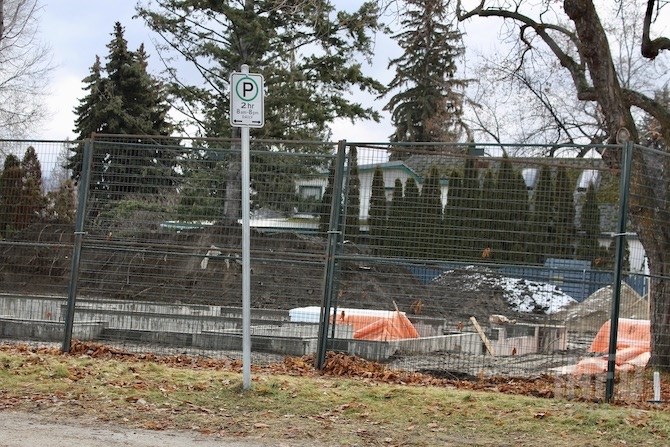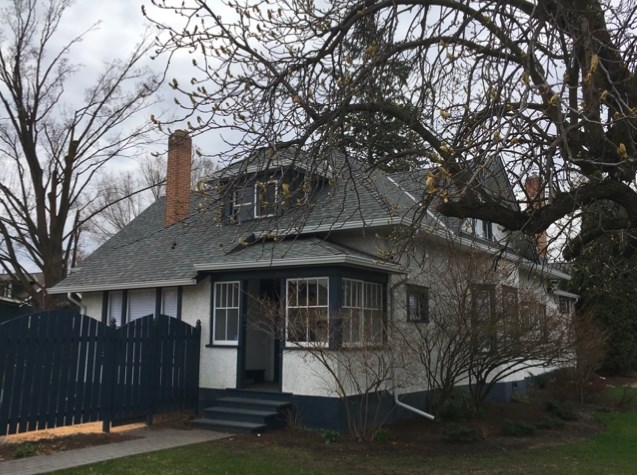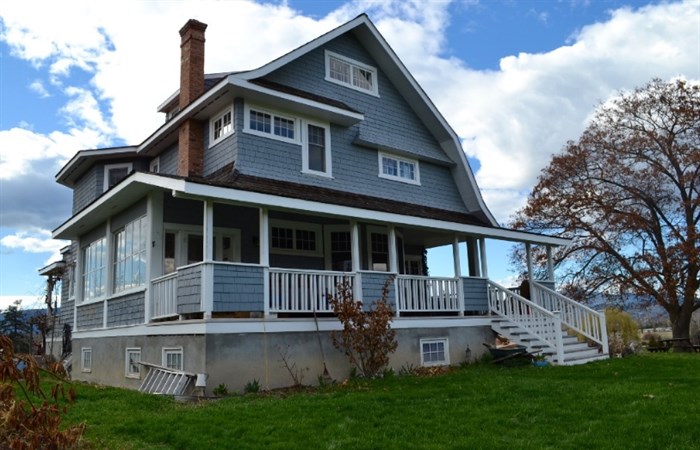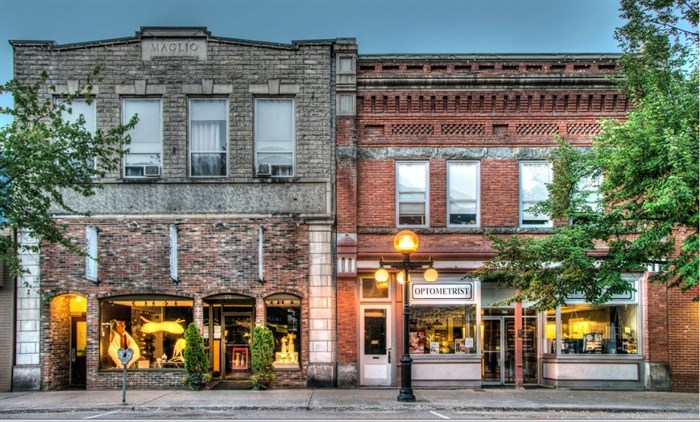
This is all that remains of a Kelowna home that was once on the city's Heritage Registry and part of the Abbott Street Heritage Conservation Area.
(ROB MUNRO / iNFOnews.ca)
January 23, 2021 - 9:00 AM
The photo above shows the current state of a Kelowna property that was demolished, even though it was once on the city’s heritage registry.
Like dozens of homes in Kelowna, Kamloops and other Okanagan communities, 409 Park Avenue’s inclusion on a registry meant very little in terms of preserving it.
Yet it is an example, not so much of local governments’ disregard for their history, but of residents who have turned their backs on their neighbours, communities and history, some heritage advocates say.
“People, I don’t think, are wedded to their communities so much anymore,” Michael Kluckner, an author, artist and the chair of the Vancouver Heritage Commission, told iNFOnews.ca. “We’ve also had a general evolution in the kind of architecture being built that is much more towards privacy. The focus is on the back yard as opposed to the front porch and street. We’ve gone from front yard culture where you would chat with neighbours and people going by to being, effectively, turned inward.”
Kluckner, who wrote books like Vanishing British Columbia and Paving Paradise, lived in West Kelowna for a time and once was viewed as having “dropped from another planet” when he gave a talk in Kamloops in the 1990s about creating a heritage conservation area in that city’s Battle Street area.
There was a time when heritage was valued, registries were created and heritage conservation areas set up where whole neighbourhoods were, at least, recognized for their historical significance, if not actually protected.
To some heritage buffs, it seems those heritage conservation efforts have now also been relegated to the past.
“Heritage has so little presence in this town,” Mel Formanski, executive director of the Kamloops Heritage Society, said. “Our present council is very pro-business, very big business. They want to be Kelowna.”

St. Andrews on the Square is the oldest public building in Kamloops
Image Credit: Submitted/Standrewsonthesquare.com
She, and others, had to fight for two years in the 1990s to restore St. Andrews on the Square, the city’s oldest public building dating back to 1887.
“We fought long and hard to get this building saved but, now that we have, we’ve now been put on their registry of wonderful places,” Formanski said. “But, before, they were going to say, just tear it down. Fortunately the citizens said, no, I don’t think so. That swayed the opinion.”
Her view is countered by Barbara Berger, recreation, social development and culture manager with the City of Kamloops.
“It’s not that the city doesn’t care,” she said. “The city does care about its built heritage and also its natural heritage. But, not every property owner is interested in designation or conservation either. They perceive that there could be limitations. They perceive that it’s going to affect their future resale if the property is protected. It isn’t just the city.”
Kamloops did invest heavily in St. Andrews on the Square, she noted, and in 2007 the city did look into creating a heritage conservation area in the west end of downtown but residents were not interested.
In Kelowna, Valerie Halford was a key fighter in the efforts to create the Abbott Street Heritage Conservation Area in the 1990s.
She went to the city in 1994 to find out about plans for Park Avenue, near Kelowna General Hospital and Okanagan Lake, because she was interested in buying a house there. She was told that it was in a heritage conservation area so she bought the house at 429 Park Avenue and restored it.

This is the home Valerie Halford bought in 1992. It's heritage character has been preserved by new owners.
(ROB MUNRO / iNFOnews.ca)
As it turned out, it wasn't actually a heritage conservation area, as she found out less than a year later when signs went up showing plans for a 43-unit apartment block on the street.
“That’s when I went ballistic,” Halford said. “We objected strenuously and advocated loudly for the creation of a heritage conservation area. It took us two years to do that.”
One home was bulldozed early one morning and trees damaged but the project never went ahead and development guidelines for the area were adopted in 1997.
Fast forward to 2020 and there have been a number of changes. Some homes have been moved in order to make room for carriage houses. Others have been added on to in ways that people like Halford don’t see as appropriate.
At 409 Park Avenue, new owners bought knowing the house was not only in the heritage conservation area but also one of about 50 on the city’s heritage register.

This is what the house at 409 Park Ave. in Kelowna looked like before it was demolished.
Image Credit: Submitted/Valerie Halford
That didn’t stop them from trying to redevelop. An inspector was hired who said the house was not worth preserving and the city allowed the owners to take it off the heritage registry. Then it was demolished. City council rejected plans for a new house supposedly designed to have a heritage feel.

This is a rendering of what the owners of 409 Park Ave. wanted to build. It was rejected by Kelowna city council.
Image Credit: Submitted/City of Kelowna
That lot now sits vacant but other homes in the conservation area have been replaced with imitation heritage buildings. Another application having been filed just before Christmas to replace the house at 360 Burne Ave. and build a carriage house on the lot as well.
It's not just the houses that need to be preserved, Halford said. The trees and gardens also give the neighbourhood a distinct character but are being destroyed in order to put larger and more buildings on each lot.
This, and other examples, show the shortcomings of existing heritage protection efforts.
Kamloops has more than 100 buildings on its heritage registry, which allows for some tax breaks and a plaque. Kelowna has fewer homes on its registry. Those owners can apply for grants to cover part of the cost of exterior repairs or renovations.
But that legislation does not offer protection. Only a formal heritage designation will protect a building from demolition and it has to be rebuilt if destroyed. Very few owners want their homes designated because of the impact on resale values. Plus, authentic heritage restoration can be very expensive.
In a rare case of heritage preservation, Mark Haley bought the Cross House in 1995 and moved it from its original location near the Abbott Street conservation area to a farm where it was converted into a bed and breakfast.
READ MORE: New way of preserving farmland championed in Okanagan, Kamloops
Earlier this year, he applied for it to be officially designated as a heritage building so it can be preserved in perpetuity.

This is the Cross House in Kelowna. It's owner applied to have it designated as a heritage building so it could be better protected.
Image Credit: Submitted/City of Kelowna
Given the controversy surrounding the Abbott Street Heritage Conservation Area, Kelowna city council did ask for an update on the process from staff this past fall.
They were told that only three or four heritage alteration permits are deemed significant enough to be presented to council each year. Other, more extensive permits, only happen once every three or four years.
Coun. Brad Sieben asked for a full review of the heritage conservation process but was told staff are too busy.
“I fully support that something needs to be done,” Mayor Colin Basran said at that council meeting. “I just don’t think in the next year or, maybe, in the next two, it’s a high priority. In my estimation, we have far greater priorities than that. This should be something that the next council should deal with.”
Given what Kluckner said about the current state of heritage appreciation, Basran may not be off track at all given that city residents are more keen to redevelop these properties than to preserve them.
That's the fault of the zoning attached to the lots the buildings sit on, Kluckner said.
In order to protect a neighbourhood from redevelopment, the zone needs to only allow new housing to be about the same size as the existing homes.
That takes away the incentive for a developer to either build much larger homes, put on additions or build carriage houses.
But, what’s needed first is for the neighbourhood to be more front-facing, Kluckner said. That builds a sense of community so people want to stay in that neighbourhood and preserve its character, whether the homes are 100 years old or 50.
That attitude is more common in places like the Kootenays where people move there with the intent of buying an older home, restoring it and enjoying the ambiance that creates, Kluckner said.

Nelson has done more than most B.C. cities to preserve its heritage buildings.
Image Credit: Submitted/City of Nelson
Nelson, for example, has 206 identified heritage sites, the largest number of any city outside Vancouver and Victoria.
But, don’t blame the Kamloops and Kelowna governments, Kluckner said. There has to be a groundswell of public support, as there was in the Abbott Street area and the St. Andrews on the Square project back in the 1990s.
“Cities have the ability to put in these heritage conservation areas,” Kluckner said. “Generally they do this in the teeth of significant opposition from the people living in the neighbourhood. People don’t want their hands tied or title encumbered in any way.”
Will that attitude change in Kelowna by the time heritage is formally reviewed in two or three or four years time?
Halford has retired from the fight and can only hope other, younger people, will take up the challenge.
In Kamloops, Formanski is getting ready to lead that struggle herself.
“Once this COVID business is over, we’re wanting to make an umbrella group or coalition of heritage-minded groups so that we have a lot more clout with the city and we’ve just got more voices that say, 'hey, wait a minute here, you’re tearing down things that are kind of important to our heritage,'” she said.
To contact a reporter for this story, email Rob Munro or call 250-808-0143 or email the editor. You can also submit photos, videos or news tips to the newsroom and be entered to win a monthly prize draw.
We welcome your comments and opinions on our stories but play nice. We won't censor or delete comments unless they contain off-topic statements or links, unnecessary vulgarity, false facts, spam or obviously fake profiles. If you have any concerns about what you see in comments, email the editor in the link above.
News from © iNFOnews, 2021